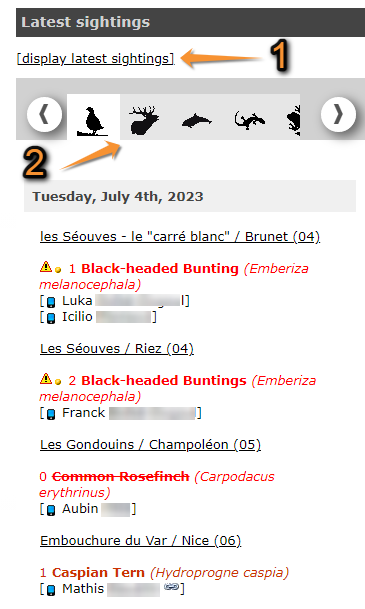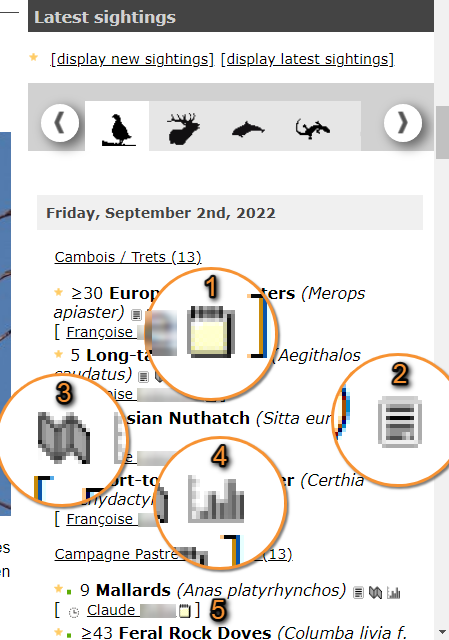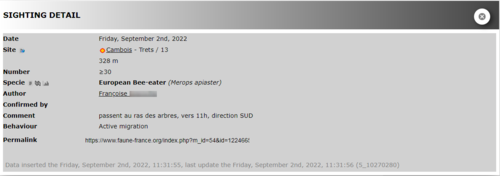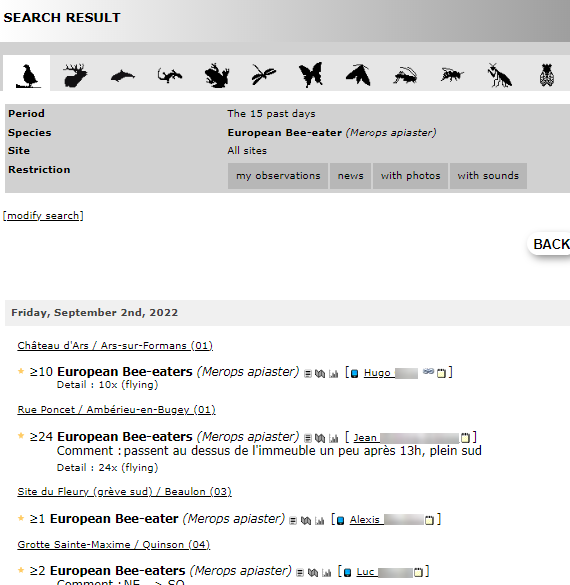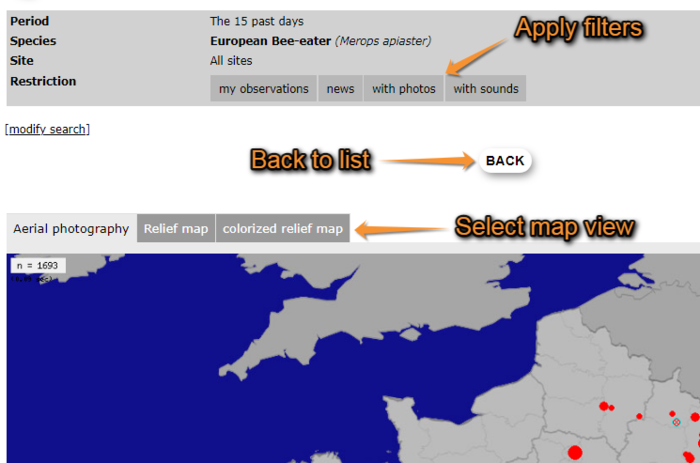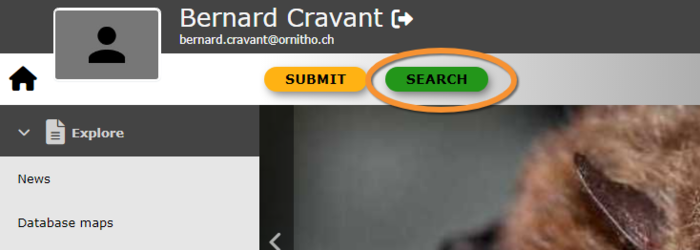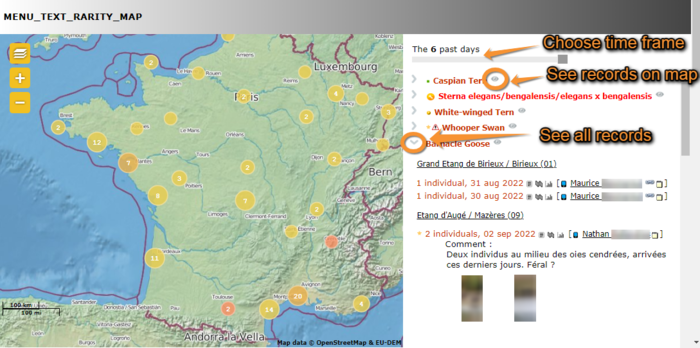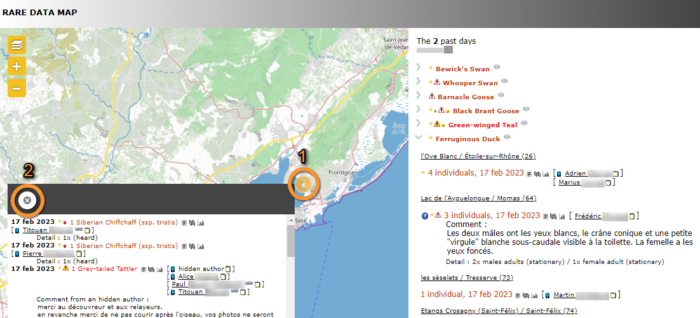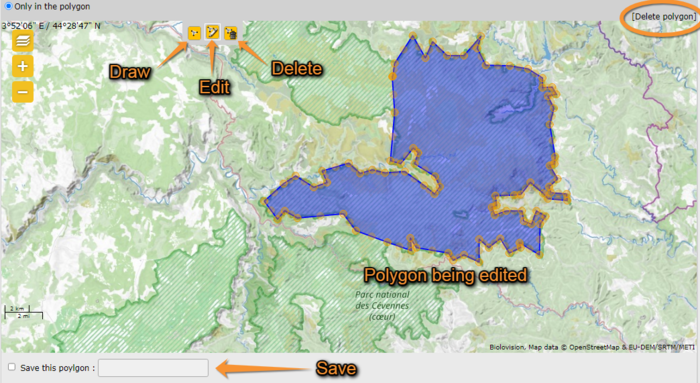Browsing records: Difference between revisions
| Line 96: | Line 96: | ||
This tab opens the rarity map. On the right, hold and drag mouse to set the number of days you want to explore. Underneath will show the list of rarities registered during the selected days. Click on the species to see all records for that species. Click on the eye icon to show on map only records for this species. Click again on the eye to return to the default view (see image [[Media:20220209WIKI rarity map 1.png|Rare birds map on list]]).<br /> | This tab opens the rarity map. On the right, hold and drag mouse to set the number of days you want to explore. Underneath will show the list of rarities registered during the selected days. Click on the species to see all records for that species. Click on the eye icon to show on map only records for this species. Click again on the eye to return to the default view (see image [[Media:20220209WIKI rarity map 1.png|Rare birds map on list]]).<br /> | ||
<br /> | <br /> | ||
[[File:20220209WIKI rarity map 1.png|700px|thumb|center|Rare birds map on list.]] | [[File:20220209WIKI rarity map 1.png|700px|thumb|center|Rare birds map on list.]]<br /> | ||
<br /> | <br /> | ||
Revision as of 10:02, 17 September 2022
One can see submitted records by other users either as a registered user or anonymously.
As an anonymous user
From latest sightings
Latest records are shown in the right hand column on the home screen (see image Browsing records as an anonymous user from 'latest sightings'). At the top there is information about the moon and sun; underneath, a map with the latest sightings, life updated; then, a statistics square on which to switch different timeframes from the tabs above. Finally, there is the list of recent sightings. Use the horizontal bar with the taxa to see the sightings associated to the selected taxa and observations will be listed underneath starting by the most recent one on top. Anonymous users cannot access more detailed information than otherwise displayed here.
For an advanced search, go to display latest sightings under the latest sightings section’s title (see image Browsing records as an anonymous user from 'latest sightings'). You can access the same search tool by clicking on the past 5 days on the right hand column under 'Explore' tab, or on the search button on the main screen. Without registration you cannot access records older than 5 days.
From Explore tab or Search button
From home screen, go to the right hand column and click on the past 5 days under Explore tab (see image Browsing records as an anonymous user from 'Explore tab'). Clicking the Search button on homescreen will show the same results.
Taxonomic group
Select using the top bar. Place pointer on the silhouette to see which taxa it represents.
Species
Choose the level of rarities you want to display (see Web interface > Codes and symbols). To select more than one option, hold CTRL key.
Site
Select the area where you want to see the records by clicking on its code, and it will turn orange. Place mouse pointer on top to see which area each number represents. By default all areas are selected. To choose more than one area, hold CTRL and click on new area. To see a list of codes and their correspondence, go to Web interface > Codes ans symbols.
Restriction
Place any restriction, as to see only those records with an attached sound or picture file.
After applying filters a list with the results will show underneath (see image Browsing records anonymously from Explore tab or Search button).
As a registered user
From latest sightings
To register, see section Web interface > Getting started > Registration. Registered users see latest sightings on the right-hand column centred on their registered area; and can either display latest sightings (the past 15 days) or display new sightings (the last 5 days) for advanced searches. Any of these options will bring you to image Browsing records as an anonymous user from 'Explore tab'.
A registered user can also access additional data and statistics for the records and observer at this stage (see image Browsing records as a registered user form latest sightings).
1. Display text: if clicking on icon 1, you are shown a summary of the observation as in image Summary of observation.
2. Sightings of species: clicking on icon 2 you can directly access all observations for this species during the past 15 days in any region. You can apply filters such as if the entry contains files, or the observation is yours (see image Browsing records as a registered user from latest sightings. List).
3. Sightings of species: returns all observations during the past 15 days for this species on a map. You can apply filters as in icon, and change the map base layer (see image Browsing records as a registered user from latest sightings. Map).
4. Statistics for the species: when available, you can access additional data about the species, like general information, numbers, observations, and so on. Use the different fields to adjust the results to specific geographical regions, or change tabs to access different sort of analysis. If interested in seeing similar data for other species you can change the taxonomic group and the species from here. Some graphs allow changing visualization of data. You can access the same data from the right hand column on your main screen, under “Explore” > “Stats” > “Contribution stats“ and “Species stats”.
5. By clicking on the observer name you can access his/her personal card and media gallery, as in section Web interface > Getting started > Customise website > “Personal card” (see image Birder details).
From Search button
After registering, click on Search at the top of the home screen (see image Browsing records as a registered user from search button).
From Explore tab
Database maps
As in Search button (see section above).
The past 5 days
As in right hand column on main screen -latest sightings- (see section Web interface > Browsing records > as an anonymous user, and image Browsing records as an anonymous user from 'Explore tab'). This list will show records according to the rarity level and region you selected in section Web interface > Getting started > Customise website > “Customize the way sightings are displayed in lists”. You can change parameters at any time under Web interface > Getting started > Customise website. Click Modify search for an advanced search (see subsection Seach engine), click News to see new records or My observations too see your observations, as in image Browsing records as a registered user. Own observations. Click on observer name to see their card (image Birder details). See correspondence of icons on the results area in image Browsing records as a registered user from latest sightings (see Browsing records > as a regisered user > from latest sightings).
Latest rare sightings
As in previous subsection, but showing only rare species for the pre-selected region.
Rare birds map
This tab opens the rarity map. On the right, hold and drag mouse to set the number of days you want to explore. Underneath will show the list of rarities registered during the selected days. Click on the species to see all records for that species. Click on the eye icon to show on map only records for this species. Click again on the eye to return to the default view (see image Rare birds map on list).
Icons next to the record or the observer name act as on image Browsing records as an anonymous user from 'latest sightings' (see section Browsing records > "As a registered user" > From Search button). Click on the site name to get information about the site. To move through the map see Web interface > Navigating the map. Click on any point on the map to get a list of rare records for this site (see image 700px|thumb|center|Rare birds map on map). Use icons and observer name as explained above.
All my observations
This is a list of your own sightings. Choose the taxonomic group from the horizontal bar on top and the timeframe. At this stage you can only choose between the last month and all data. To select a different timeframe go to modify search (see Search engine below). Apply some filters under restriction, such as if the record has pictures attached, and see the results underneath. To see other options go to Search engine below. You can see all records submitted to the website since my last visit by selecting “Restrictions > News” (see image Browsing records as a registered user from Explore tab. Rare birds map). From this screen you can also export your data in different formats (see section Web interface > Exporting your data, image Exporting your data). For a more advanced search, click on Modify search to go to the Search engine form (see next subsection).
Search engine
Period: choose between seeing all records on the database, those between specific dates or during a certain part of the year, or those from the last few days. To ease the search, you have some quick access labels underneath the fields.
Species: choose from all species, a single one, or a full family; and the rarity level to be displayed.
Sites: choose which regions, municipality, specific site, or all locations you want to see the records from. You can also select a specific square from the atlas, or a hand drawn area from the map below. To move across the map see section Web interface > Navigating the map. To select the area you want to see the records from, select the drawing icon (see image Search by polygon). Left click once on the map to start drawing and continue clicking in any of the angles. To end the polygon, double click at the last angle. To edit the polygon, select the editing icon on image Search by polygon. When clicking on the polygon, yellow dots will appear on all angles of the polygon, click and drag any to its new position. As you do so, new yellow dots will appear to help you draw the required shape. To finish editing, de-select the icon. To delete a polygon select the corresponding icon on the map (see image Search by polygon). Be careful, as it will delete without asking for confirmation. If you want to save the polygon for further searches, select the option below and enter a name.
Other restrictions: applies other specific search criteria such as if there is picture or not, select only for records waiting for confirmation, atlas code, etc.
Formatting results: determines how you want to visualize the results on the list and on the graphs.
Galleries
Gives you access to the file collection, both images and sound. See section Gallery.
